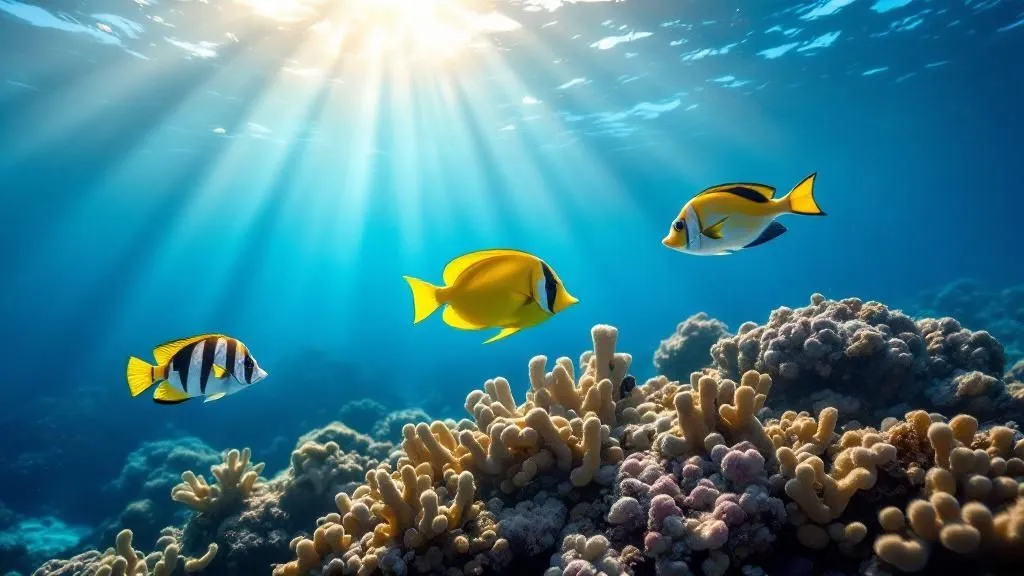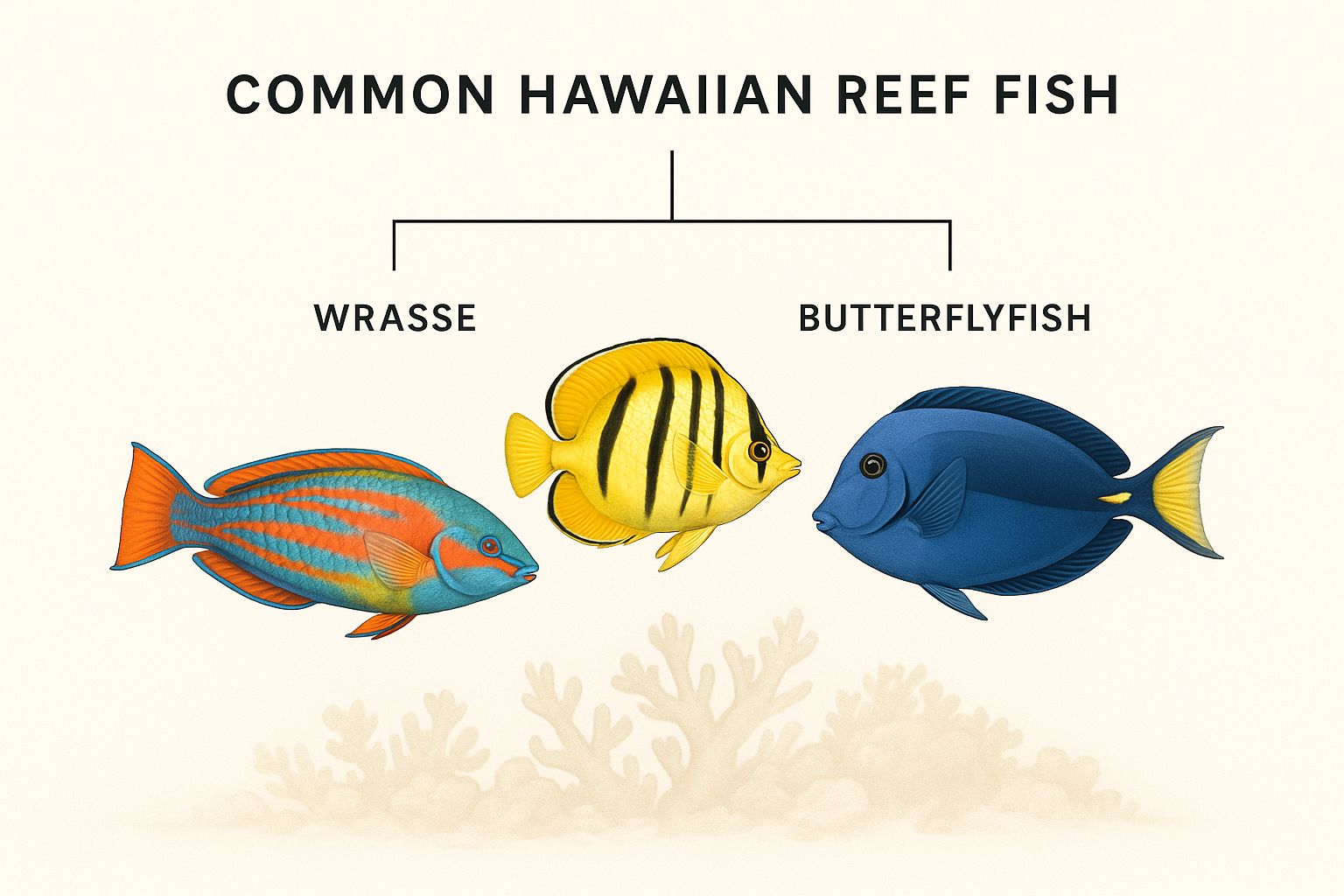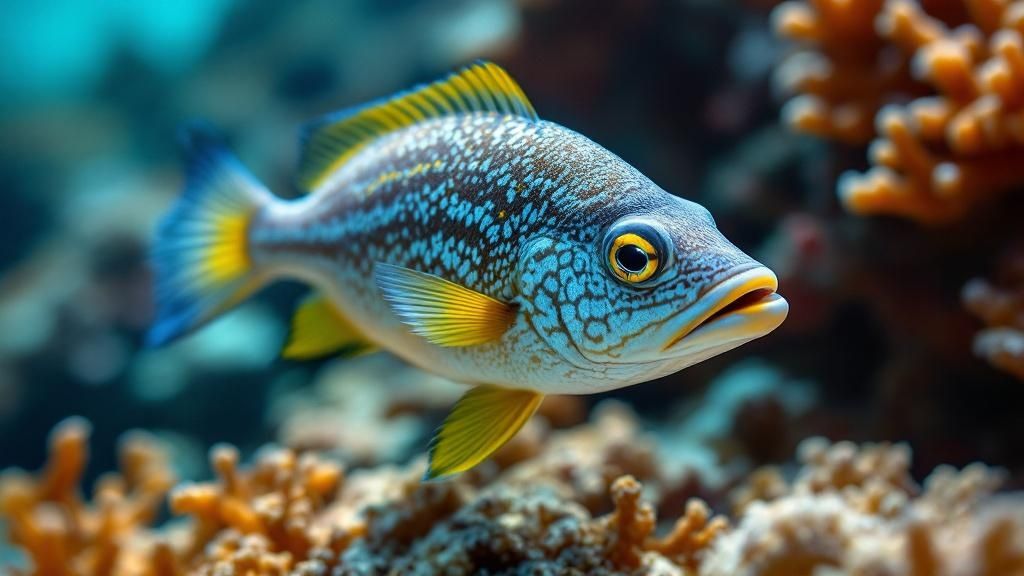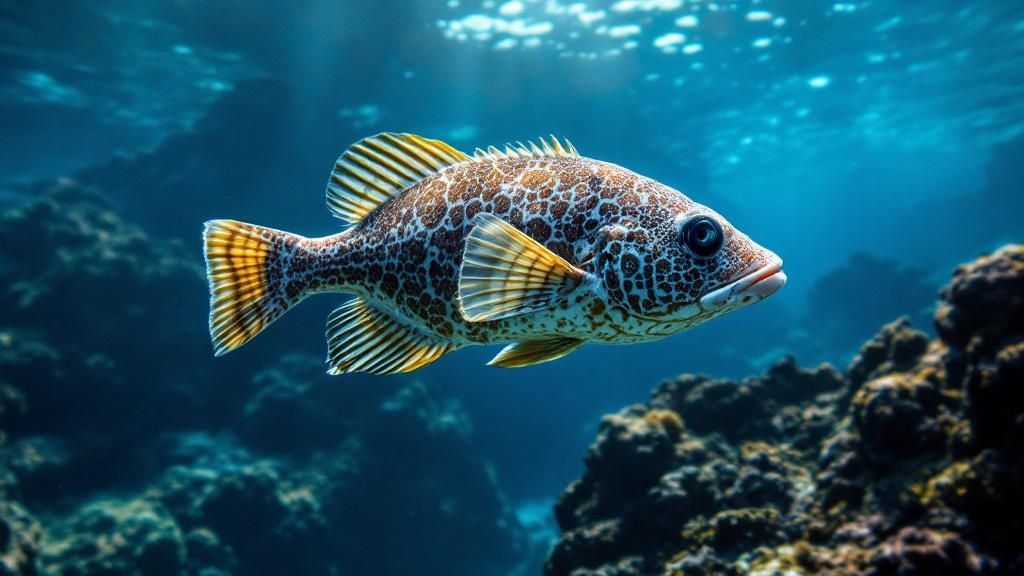Hawaiian Fish Identification Guide for Snorkelers

If you're heading out for a snorkel or dive in Hawaii, having a good Hawaiian fish identification guide on hand is a game-changer. It's the key to turning a pretty underwater view into a real connection with the reef. You'll go from just seeing "a yellow fish" to confidently pointing out a specific species, whether it's the ever-present Saddle Wrasse or the iconic Humuhumunukunukuāpuaʻa.
Your Essential Guide to Identifying Hawaiian Reef Fish
Think of this as your go-to reference for getting to know Hawaii's incredible reef fish. I’ve put this together for everyone, from first-time snorkelers sticking close to the shore to seasoned divers exploring deeper ledges. The goal is simple: give you the knowledge to start recognizing what you’re seeing, right from your first dip in the water.
When you start to learn a few key fish families and their quirks, your time in the water transforms. It's no longer just passive sightseeing; it becomes an active treasure hunt.
Of course, knowing what you're looking at is only half the battle; you also need the right equipment. To make sure you’re all set for a safe and amazing day on the water, take a look at our breakdown of essential gear for snorkeling on the Big Island Hawaii.
Getting Started with Fish Families
The secret to not feeling overwhelmed is to forget about memorizing hundreds of individual fish species right away. Instead, start by learning to spot the most common fish families. It’s a much easier approach. Each family shares tell-tale characteristics in its body shape, the way its fins look, and even how it behaves. Once you get these down, you'll have a solid foundation for identifying specific fish later.
We'll focus on the big players you’re almost guaranteed to see on any Hawaiian reef:
- Butterflyfish: These are the classic, brightly colored fish with thin, disc-shaped bodies and beautiful, complex patterns.
- Surgeonfish: Their giveaway feature is a razor-sharp spine (like a surgeon's scalpel) at the base of their tail.
- Wrasses: This is a huge and diverse family. They come in all sorts of shapes and sizes, often with brilliant colors that can change as they age.
- Parrotfish: You can't miss these guys. They have fused teeth that form a parrot-like beak, which they use to crunch on coral.
From my experience, the real trick to getting good at fish ID is to look beyond just the color. Pay attention to the fish’s body shape, where its mouth is and what it looks like, and how it swims. Is it skittish? Is it picking at the reef? These behavioral clues often tell you more than a color pattern ever could.
To help you get started, I’ve put together a quick reference table. Use this to quickly get your bearings when you see a fish you don't recognize.
Quick Identification Key for Common Hawaiian Fish Families
This table is your cheat sheet. It summarizes the key visual and behavioral traits of the fish families you'll see most often. When you spot something, run through these points in your head to quickly narrow down the possibilities.
| Fish Family | Key Identifying Feature | Common Habitat | Example Species |
|---|---|---|---|
| Butterflyfish | Flat, disc-shaped body; small, puckered mouth. | Coral-rich areas, often in pairs. | Ornate Butterflyfish, Teardrop Butterflyfish |
| Surgeonfish | Oval body with a sharp "scalpel" spine near the tail. | Grazing on algae over rock and reef. | Yellow Tang, Achilles Tang |
| Wrasse | Often cigar-shaped; swim with their pectoral (side) fins. | Everywhere on the reef, from sand flats to coral heads. | Saddle Wrasse, Christmas Wrasse |
| Parrotfish | Fused, beak-like teeth; large, heavy scales. | Actively scraping algae from coral and rock. | Spectacled Parrotfish, Stareye Parrotfish |
Keep this guide handy, and you'll be surprised how quickly you start putting names to all the colorful faces you meet on the reef. It makes every single snorkel and dive that much more rewarding.
Getting to Know the Main Fish Families of Hawaii
When you first dip your mask into Hawaii's waters, the sheer number of fish can feel a little overwhelming. But here's a secret that experienced snorkelers and divers live by: don't try to memorize every single fish. Instead, start by learning the major fish "families." It's like learning the different neighborhoods in a city before you try to learn every street name. This approach makes identifying what you're seeing so much easier, letting you quickly categorize a fish by its shape and behavior, which are often more reliable clues than color.
Thankfully, you're not on your own. Modern field guides have made this task way more approachable for everyone. The best ones, like The Ultimate Guide to Hawaiian Reef Fishes, catalog 386 reef and shore fish species around the islands, complete with fantastic photos and straightforward descriptions. They are an absolute game-changer for anyone wanting to put a name to the colorful faces they meet on the reef.
Let’s dive into the four most common families you’re almost guaranteed to encounter.
The Big Four on Hawaiian Reefs
Butterflyfish (Chaetodontidae):
Think of these as the graceful, delicate artists of the reef. They have thin, almost perfectly round bodies—nearly as tall as they are long. Their most telling feature is a tiny, puckered mouth, perfectly designed for plucking small critters from tight coral crevices. You'll almost always see them fluttering about in pairs, a true classic Hawaiian reef sight.
Surgeonfish (Acanthuridae):
This family, which includes the iconic Yellow Tang, has a seriously cool defensive trick. Tucked away at the base of their tail on each side is a razor-sharp spine, like a tiny scalpel. While you won't always see it deployed, that hidden weapon is the dead giveaway that you're looking at a surgeonfish. They are some of the most active grazers on the reef.
This image shows a vibrant butterflyfish, a sleek surgeonfish, and a colorful wrasse together, representing some of the most common families you'll see.

Notice how different their body shapes are—that's one of the best ways to tell these key groups apart, even from a distance.
Wrasses and Parrotfish
Wrasses (Labridae):
Welcome to one of the biggest and most varied families on the reef. They're a bit harder to pin down because they come in all shapes and sizes, from cigar-shaped swimmers to chunkier fish, all splashed with a wild rainbow of colors. The one thing that unites them is how they swim: they flap their side (pectoral) fins, almost like they're flying through the water. Once you spot that distinctive flapping motion, you'll start seeing wrasses everywhere.
Parrotfish (Scaridae):
You might actually hear a parrotfish before you see one. These large, impressive fish have fused teeth that form a powerful beak, which they use to scrape algae off coral and rock. That crunching sound is the sound of Hawaii's famous white sand beaches being made! This feeding is crucial for the health of the reef. With their brilliant, often psychedelic colors and big scales, they are impossible to miss.
Detailed Profiles of Butterflyfish and Angelfish

Ask any snorkeler to name a classic reef fish, and they'll probably describe a butterflyfish or an angelfish. They’re the dazzling jewels of the Hawaiian reef, and with their bright colors and flat, disc-like bodies, it’s easy to get them mixed up. But once you know what to look for, telling them apart becomes second nature.
The biggest giveaway is a feature most people never notice. Angelfish have a sharp, prominent spine on their lower gill cover, called the preopercle spine. Butterflyfish don't have this. It's a small detail, but it's foolproof. You'll also find that butterflyfish are pretty common on shallow reefs, while most of Hawaii's angelfish prefer deeper water and are a rarer sight for snorkelers.
Fourspot Butterflyfish (Chaetodon quadrimaculatus)
If you spend any time on a Hawaiian reef, you're almost guaranteed to meet the Fourspot Butterflyfish. This is one of the most common and recognizable butterflyfish in the islands. Its upper body is a brilliant, sunny yellow that darkens into a deep, almost black, lower half. The name is a dead giveaway—it comes from the two obvious white spots on each side.
- Key Markings: The most telling feature is the pair of bright white spots on each side, set against that dark lower body. You'll also see a dark bar running vertically through its eye, which is a classic camouflage trick for this family.
- Size: They typically grow to about 6 inches (15 cm).
- Habitat: Look for them in coral-rich shallows and along outer reef slopes. They're often in pairs, gracefully fluttering around coral heads where they feed on coral polyps.
Its bold look makes it a favorite for underwater photographers and a really satisfying fish to check off your list for the first time.
Ornate Butterflyfish (Chaetodon ornatus)
While the Fourspot is common, the Ornate Butterflyfish is a truly stunning sight, though you’ll have to look a bit harder to find one. Its body is a clean, silvery-white canvas crossed with bold, diagonal orange bands. It’s a fish that really pops against the blue water.
Pro Tip: The best way to be sure you've spotted an Ornate is to count the stripes. It has a very distinct pattern of six to eight orange stripes that sweep back along its body. It also has two black bars on its head—one through the eye and another across its "forehead."
This species is the perfect example of why learning patterns is more reliable than just going by color. "White and orange fish" could describe a lot of things, but those precise stripes are unmistakable.
Potter’s Angelfish (Centropyge potteri)
Here’s a real Hawaiian treasure. The Potter’s Angelfish is one of the few angelfish species you have a decent chance of spotting while snorkeling. What makes it extra special is that it's endemic to the Hawaiian Islands, meaning this is the only place on Earth you can find it.
This little fish is a stunner, with a fiery orange-red front that melts into a deep, electric blue back half. The whole body is covered in thin, dark, squiggly vertical lines. And don't forget the acid test for an angelfish—look for that little spine on its cheek to seal the deal on your ID.
Identification Checklist for Potter's Angelfish:
- Color Pattern: Does it have that bright orange head and front?
- Transition: Does the orange fade into a dark, rich blue rear and tail?
- Markings: Can you make out those fine, dark vertical lines across its body?
- Size: Is it small, maybe around 4 inches (10 cm)?
- Habitat: Are you over a rocky or rubble bottom with lots of algae, probably deeper than 15 feet?
Learning these specific markers is what separates a casual observer from someone who really knows the reef. It adds a whole new layer of fun and expertise to your underwater adventures.
Identifying Surgeonfish, Tangs, and Unicornfish
Of all the fish buzzing around a Hawaiian reef, the Surgeonfish family, or Acanthuridae, are some of the most active and vital. You’ll often hear them called Tangs, and they’re named for a very specific, very cool defensive weapon: a razor-sharp spine, like a tiny scalpel, tucked away on each side of their body right at the base of the tail.
This little spine is the dead giveaway. It usually sits flat inside a groove, but if a fish gets spooked, it can flick that scalpel straight out to send a clear message to predators. Being able to spot this feature is one of the first things you learn when identifying fish here in Hawaii. Once you see it, you know you’re looking at a member of this incredible family.
Yellow Tang (Lauīpala)
The Yellow Tang is pure Hawaiian sunshine in fish form. It’s hard to miss that brilliant, solid yellow body, which makes it a showstopper for snorkelers and a dream subject for photographers. That vibrant color just pops against the dark volcanic rock and deep blue waters of the reef.
But they’re not just pretty faces. These fish are the reef's gardeners, constantly grazing on turf algae. Without them, that algae could completely take over and choke out the coral. You’ll almost always see them moving in loose schools, like a bright yellow cleaning crew sweeping across the reef flats.
Quick Identification Cues:
- Color: An unmistakable, solid, vibrant yellow.
- Scalpel: Look for a small, white spine at the base of its tail.
- Behavior: Usually in groups, busy munching on algae across rocks and coral.
- Size: They grow up to about 8 inches (20 cm) long.
Achilles Tang (Pākuʻikuʻi)
Spotting an Achilles Tang for the first time is a moment you won’t forget. This fish is stunning. It has a deep, velvety black body that’s punctuated by a dramatic, teardrop-shaped orange spot right by its tail. As if that weren't enough, it has splashes of bright orange along its dorsal and anal fins, creating a truly striking contrast.
You won't find these guys in calm, quiet bays. Achilles Tangs love the high-energy zones—think shallow reef tops with lots of surge and crashing waves. They’re much more solitary than their yellow cousins and can be pretty shy, so if you want a good look, approach slowly and calmly.
The Achilles Tang is a classic example of a fish perfectly built for its environment. Its love for turbulent, oxygen-rich water means you'll have the best luck finding it on the exposed outer edges of the reef, not tucked away in a protected cove.
Bluespine Unicornfish (Kala)
The Bluespine Unicornfish is one of the bigger members of the surgeonfish family you’re likely to run into. While the name “unicornfish” might make you expect a horn, this particular species doesn’t have one. Instead, you’ll know it by its solid grayish-brown body and, more importantly, the two pairs of bright blue, forward-facing spines at the base of its tail.
Unlike the retractable scalpel on a tang, these spines are fixed and always visible—a permanent warning. Kala often travel in huge, impressive schools that cruise over the reef. When they get agitated or excited, they can "flash" a much lighter, almost electric bluish color, which is an incredible sight. Their sheer numbers and constant motion make them a powerful presence on the reef.
A Closer Look at Wrasses and Parrotfish

If you've spent any time on a Hawaiian reef, you've definitely seen wrasses and parrotfish. They're some of the most active and vividly colored fish out there, but they can also be the trickiest to identify. Why? Because many of them completely change their look—and sometimes even their sex—as they get older. A young fish can look so different from a mature adult that you'd swear they were two separate species. Getting a handle on these transformations is one of the biggest "aha!" moments in learning a Hawaiian fish identification guide.
The secret is all about understanding their life phases. Most of these fish begin in an initial phase, where they could be female or a young, non-breeding male. Later on, a dominant female might transform into a stunningly vibrant terminal phase male. This is the reason you'll often see two fish that are technically the same species swimming together, yet looking completely unrelated.
Understanding Wrasse Identification
The wrasse family (Labridae) is just massive and incredibly varied. One of the best ways to spot them is by how they swim. Instead of using their tails for propulsion, they tend to "fly" through the water by flapping their pectoral (side) fins. It’s a very distinct movement.
A great one to learn first is the Saddle Wrasse (Hīnālea lauwili), because you'll see them everywhere. They are constantly zipping around the reef. Look for a greenish body, a bluish head, and that unmistakable reddish-orange "saddle" right behind their side fin.
Another classic is the Christmas Wrasse (‘Awela). The terminal male is an absolute showstopper, decked out in brilliant greens and blues with a bold pink or red stripe from its eye all the way to its tail. The initial phase fish, on the other hand, is much more drab and easy to overlook.
Parrotfish: The Reef's Sand Makers
Parrotfish (Uhu) are named for their fused teeth, which create a hard, beak-like mouth perfect for scraping. In fact, you might actually hear them before you see them—listen for a distinct crunching sound as they bite off algae from coral and rocks. This is a crucial job for the reef ecosystem. After they digest the algae and coral bits, they excrete fine, clean sand, playing a huge part in creating Hawaii's famous white sand beaches.
You'll almost certainly run into the Spectacled Parrotfish (Uhu-uliuli). The terminal male is a gorgeous deep blue-green, highlighted by pink markings around its face that look like a pair of glasses. The initial phase is a more camouflaged, mottled reddish-brown.
Key Takeaway: When you spot a big group of dull, brownish parrotfish with just one or two brightly colored individuals leading the pack, you're almost certainly looking at a single species. Those colorful ones are the terminal phase males, in charge of a harem of initial phase females and juveniles.
While you'll find plenty of these fish in the shallows, the story of Hawaiian reef fish spans all depths. Some species, like Tinker’s butterflyfish and orange-margin butterflyfish, prefer the deeper slopes beyond 30 meters. Certain angelfish also stick to depths of 20 meters or more, especially around steep drop-offs. For a deeper dive into the data on these habitats and the health of our reefs, the State of Hawaii's aquatic resources division offers a fascinating historical snapshot.
Alright, let's move past the everyday grazers and get to know some of the reef's real characters. This part of our Hawaiian fish identification guide is all about three unforgettable families: Triggerfish, Goatfish, and Pufferfish.
Once you know their secrets, they're impossible to miss. Each one has its own unique look and set of behaviors that make spotting them a real treat. We'll cover everything from Hawaii's state fish and its clever defense trick to the sand-sifters with their funny "whiskers."
Triggerfish: The Reef’s Fortified Guardians
You'll know a Triggerfish the moment you see one. They have these distinct, diamond-shaped bodies and a peculiar way of swimming, propelling themselves with a synchronized flutter of their top and bottom fins. It's kind of a neat, wavy motion.
But their claim to fame is a brilliant defensive tool: the trigger spine. The first spine on their back is big and tough. When a predator comes along, the fish can raise that spine and lock it in place with a second, smaller "trigger" spine. This lets them wedge themselves tightly into a crack in the reef, making it almost impossible for anything to pull them out.
Reef Triggerfish (Humuhumunukunukuāpuaʻa):
This is Hawaii's state fish, and it's a true local celebrity. You can't mistake the Humuhumunukunukuāpuaʻa with its wild, geometric blocks of yellow, black, and blue. It looks like a piece of modern art swimming by.
- Key Markings: Look for the sharp, "V" shaped black band running from behind its pectoral fin toward the tail, and that bright yellow snout.
- Behavior: They're usually loners. You'll often see them hovering over sandy patches, blowing jets of water to uncover tasty little crabs and worms.
- Size: A full-grown adult will be about 10 inches (25 cm) long.
Goatfish: The Sand Probers
Goatfish get their name from the two long barbels dangling from their chins, which really do look like a little goat's goatee. These aren't just for looks, though. They're packed with chemosensory organs, letting the fish "taste" and "feel" around in the sand for shrimp, worms, and other invertebrates.
When you see a Goatfish actively hunting, it’s a busy scene. They stir up little clouds of sand with their barbels, and you'll almost always see a few opportunistic wrasses tagging along, hoping to snatch a free meal.
Yellowstripe Goatfish (Weke):
This is one of the most common Goatfish you'll spot in Hawaii. It has a silvery-white body with a single, unmistakable yellow stripe running from its eye all the way down to its tail.
- Distinguishing Feature: That bold, continuous yellow line along its side is the dead giveaway.
- Habitat: You'll find them hanging out over sandy bottoms right next to the reef, sometimes resting in small schools or busy digging for food.
Snorkeler's Tip: See a fish poking around in the sand with two "whiskers"? You’ve found a Goatfish! From there, just look at the patterns. If it has that single yellow line, it's a Weke. If it has a bunch of vertical stripes, you're likely looking at a Manybar Goatfish.
Pufferfish: The Inflation Experts
Pufferfish, and their spikier cousins the Porcupinefish, are famous for one spectacular trick: they can blow themselves up like a balloon. When they feel threatened, they gulp down water and inflate into a big, spiny ball that’s several times their normal size.
This sudden transformation makes them a completely unappetizing—and practically impossible—meal for most predators. On top of that, they have powerful, fused teeth that form a beak, which is perfect for crunching through the hard shells of crabs and mollusks.
Their slow, almost clumsy swimming style is another clue to look for. This combination of shape, behavior, and an incredible defense mechanism makes them one of the most fascinating fish to watch for in any Hawaiian fish identification guide.
How to Protect Hawaii's Reef Ecosystem
There's a special connection that forms when you start putting names to the fish you see darting around the reef. It’s a profound experience, but it also comes with a real responsibility to protect the very place these fish call home. The vibrant reefs you're exploring, from the calm, sandy lagoons to the dramatic deep-water drop-offs, are incredibly delicate and facing a lot of pressure. What you do as a visitor has a direct, powerful impact on their survival.
Being a conscious observer is the first step. Think of it as turning your new fish ID skills into a tool for conservation. When you know a fish's name, you start to understand its role in the ecosystem, the specific habitat it needs, and its vulnerabilities. This simple shift in perspective can transform you from a tourist into a true steward of the reef.
Practice Responsible Reef Etiquette
Every single interaction you have with the reef matters. If you remember nothing else, remember this: never touch, stand on, or kick the coral. It might look like rock, but coral is a living animal. Even a light touch can strip away its protective mucus layer, leaving it wide open to disease. It's just as important to give all marine life plenty of space, allowing them to go about their business without feeling stressed or threatened.
Here are a few essential habits to get into on every single snorkel or dive:
- Use Reef-Safe Sunscreen: Many common sunscreens have chemicals like oxybenzone and octinoxate, which are proven to cause coral bleaching. Stick with mineral-based sunscreens that use zinc oxide or titanium dioxide. These are your friends, and the reef's friends, too.
- Secure Your Gear: Make sure your fins, camera, and any other gear are clipped on tight and not dangling. A stray fin kick or a dangling GoPro can do a lot of accidental damage. For more on getting your gear sorted, our guide on snorkeling safety tips has some great pointers.
- Leave No Trace: This one's simple. Take only pictures, leave only bubbles. Don't take anything from the reef—not shells, not rocks, not even a bit of sand. And, of course, make absolutely sure no trash gets left behind.
Understand the Bigger Picture
Beyond your own actions in the water, it helps to understand the larger context. Hawaii's reefs aren't just postcard-perfect scenery; they're vital economic and cultural engines for the islands. For example, a staggering 1.2 million kilograms of reef fish are harvested from these waters every year for food and the aquarium trade. When we understand the life cycles of these fish, it helps inform sustainable practices that protect breeding populations for the future. You can dive deeper into the science behind sustainable Hawaiian reef fish management to see how complex and important this work is.
By simply choosing to snorkel and dive with respect, you become an active part of preserving Hawaii's underwater world. Your mindful presence helps make sure that future generations can have these same magical experiences, using their own Hawaiian fish identification guide to discover the wonders you're seeing today. Every small, respectful action adds up to a healthier, more resilient ecosystem for everyone.
Hawaiian Fish Identification FAQ
When you're face-to-face with the incredible rainbow of fish on a Hawaiian reef, you're bound to have some questions. We get it. We hear them all the time from new and experienced snorkelers alike. This section is here to tackle those common curiosities, giving you quick, clear answers to help you get the most out of this fish guide and your time in the water.
So, what’s the fish you're almost guaranteed to see? Hands down, it's the Saddle Wrasse (Hīnālea lauwili). They are everywhere and easily one of the most abundant fish on the reef. Look for a greenish body, a striking blue head, and that tell-tale orange-red "saddle" right behind its side fin. You can't miss it.
A lot of people also ask if they can just use a generic Caribbean or Indo-Pacific fish ID guide here. While a few fish have huge ranges, Hawaii is famous for its staggering number of endemic species—that means they live here and absolutely nowhere else on Earth. For that reason, a Hawaii-specific guide is a must-have for getting your IDs right.
Understanding Fish Behavior and Appearance
One of the biggest head-scratchers for snorkelers is seeing two fish that look wildly different, only to learn they're the same species. What gives? This is super common with families like Wrasses and Parrotfish, which go through incredible color and pattern shifts as they age.
A fish in its "initial phase" (which is often a female or a younger fish) can look like a completely different animal compared to a mature "terminal phase" male.
Here's a pro tip from years of watching these guys: learn to look past the color. Pay attention to the fish's body shape, the way it swims, and what it's doing. These clues are often way more reliable for an ID than color, which can change dramatically.
Of course, everyone wants to know about Hawaii's state fish. That's the one-and-only Reef Triggerfish, better known by its magnificent Hawaiian name, Humuhumunukunukuāpuaʻa. It’s pretty easy to spot with its angular body, bold patches of color, and the famous "trigger" spine on its back that it pops up for defense.
While you’re out there spotting fish, you’ll likely run into some of the reef's other incredible residents. If you're curious about the gentle, ancient reptiles cruising the coastline, you can learn all about what kind of sea turtles are in Hawaii in our dedicated article.
Ready to put your new identification skills to the test on an unforgettable adventure? Join Kona Snorkel Trips for a guided tour of Hawaii's most spectacular reefs. Book your spot today at https://konasnorkeltrips.com
